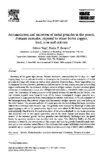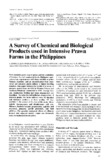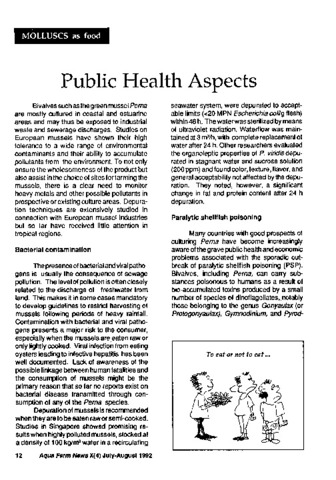Accumulation and excretion of metal granules in the prawn, Penaeus monodon, exposed to water-borne copper, lead, iron and calcium
- Global styles
- MLA
- Vancouver
- Elsevier - Harvard
- APA
- Help

閲覧/開く
日付
1994Page views
4,499ASFA keyword
AGROVOC keyword
Taxonomic term
Metadata
アイテムの詳細レコードを表示する
Share
抄録
Juveniles of the giant tiger prawn, Penaeus monodon, were exposed for 10 days to 1 mg/l copper, lead, iron or calcium in order to investigate the formation and accumulation of metal granules in major soft tissues as well as their excretion from the body. Metal deposition was investigated by histochemistry and electron microscopy in the hepatopancreas and surrounding organs and tissues like the stomach, midgut, anterior midgut caecum, thoracal antennal gland extensions, haematopoietic tissue, and interspersed musculature, connective tissue and pigment tissue. The abundance of metal granules varied greatly between the metals and the tissues. Iron and calcium deposits were found in none of the tissues investigated. Copper granules were accumulated in high quantity in the hepatopancreas tubules, were scarce in the antechamber of the hepatopancreas, the anterior midgut and the anterior midgut caecum, and were lacking in the other tissues. The amount and size of copper granules increased along the hepatopancreas tubules in accordance with the cells' age. The granules were released by discharge of senescent hepatopancreas cells in the antechamber region and were added to the faeces. Lead granules were primarily found in the thoracal extensions of the antennal gland. In the hepatopancreas they occurred only in very small quantities, and in the other organs and tissues they were absent. In the antennal gland, the lead granules were individually discharged into the gland lumen by apocrine secretion and excreted with the urine. The observed ability of Penaeus monodon to detoxify and remove metals like copper and lead by granule formation and excretion and to prevent other metals like iron from entrance into major soft tissues corroborate that decapods are no suitable organisms for a long-term biomonitoring of heavy metal pollution.
Suggested Citation
Vogt, G., & Quinitio, E. T. (1994). Accumulation and excretion of metal granules in the prawn, Penaeus monodon, exposed to water-borne copper, lead, iron and calcium. Aquatic Toxicology , 28(3-4), 223-241. https://doi.org/10.1016/0166-445X(94)90035-3
Type
ArticleISSN
0166-445XCollections
- Journal Articles [1256]
Related items
Showing items related by title, author, creator and subject.
-
Fate and effects of water-borne heavy metals in Penaeus monodon
Heavy metals impair the aquaculture of shrimps and the quality of shrimp products. Some heavy metals occur in high amounts particularly in the hepatopancreas and the antennal gland (Gibson and Barker, 1979). This study was ... -
A survey of chemical and biological products used in intensive prawn farms in the Philippines
Primavera, Jurgenne ; Lavilla-Pitogo, Celia R.; Ladja, Jocelyn M.; de la Peña, Milagros R. (Elsevier, 1993)
With attractive prawn export prices and the availability of hatchery fry and commercial feeds, Philippine aquaculture has experienced a shift from milkfish to prawn Penaeus monodon and an intensification from traditional ...
; Lavilla-Pitogo, Celia R.; Ladja, Jocelyn M.; de la Peña, Milagros R. (Elsevier, 1993)
With attractive prawn export prices and the availability of hatchery fry and commercial feeds, Philippine aquaculture has experienced a shift from milkfish to prawn Penaeus monodon and an intensification from traditional ... -
Public health aspects: Molluscs as food
Castaños, Milagros T.; Southeast Asian Fisheries Development Center, Aquaculture Department (Aquaculture Department, Southeast Asian Fisheries Development Center, 1992)





